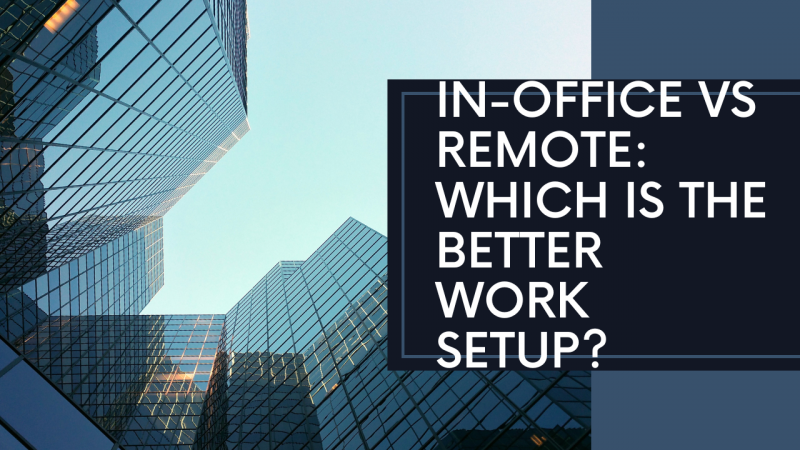In-Office vs Remote Work: Finding Your Ideal Balance
The ongoing debate regarding In-Office vs Remote work has persisted for quite some time. In April 2020, amid widespread lockdowns, organizations swiftly transitioned to accommodate remote work. It soon became evident that many white-collar roles required little more than a laptop and internet access.
While a significant portion of the workforce embraced the newfound flexibility of remote work, others faced challenges adapting, fueling a global discussion on the merits and drawbacks of in-office, remote, and hybrid work arrangements.
Remote Work on the Rise
One of the key drivers behind the surge in remote work adoption is the flexibility it offers. Remote work allows employees to create a more balanced lifestyle by eliminating long commutes and providing the freedom to structure their workday around personal commitments.
This newfound flexibility has been a game-changer for many individuals, leading to increased job satisfaction and overall well-being.
In this in-depth analysis, we explore the latest remote work statistics shaping professional landscapes and working environments nationwide.
Remote Work Statistics
As we further discuss the impact of Remote work, some of the key statistics stand highlighted and relevant to determine the future of work:
By 2025, 32.6 million Americans will work remote by 2025
Looking into the future, it looks like remote work is going to keep booming.
A recent study suggests that by 2025, around 32.6 million Americans – that’s about 22% of the workforce – will be working remotely.
It’s a sign that the trend toward remote work is on a steady rise, shaping how we work in the coming years.
98% of workers want to work remote at least some of the time
It’s fascinating to note how workers’ preferences are perfectly in sync with this trend. 98% of workers have expressed their desire to work remotely, even if it’s just part of the time.
This overwhelming statistic mirrors the workforce’s increasing love for the flexibility, independence, and work-life balance that remote work brings to the table.
93% of employers plan to continue conducting job interviews remotely
Looking at it from the employers’ viewpoint, the embrace of remote work is clear too. An impressive 93% of employers intend to keep conducting job interviews remotely.
This shows their readiness to adjust to virtual approaches and acknowledges remote work as a viable, long-term option.
16% of companies operate fully remote
About 16% of companies have embraced full remote operations, eliminating the need for a physical office.
These innovative companies are pioneers in the remote work movement, demonstrating the effectiveness of such setups and encouraging others to follow suit.
In-Office vs Remote Work
The ongoing debate surrounding remote versus office work brings to light the unique advantages of each.
Remote work offers a plethora of benefits, enhancing flexibility in various ways.
It enables employees to reside in areas farther from traditional office hubs, reduces time spent commuting, and empowers individuals to craft their work schedules around caregiving responsibilities or personal interests
On the flip side, office work provides a structured environment and fosters deeper connections among employees.
Offices facilitate formal face-to-face interactions such as meetings and team gatherings, as well as informal conversations like spontaneous chats at the watercooler that are challenging to replicate virtually.
Gig Economy and Freelancers’ Impact
It’s worth mentioning the impact of the gig economy and freelancers on the remote work landscape. With more individuals opting for freelance or gig-based work, remote work becomes even more appealing.
Freelancers can work from anywhere, contributing to the rise in remote work opportunities and shaping the future of work dynamics.
Future Outlook
Many companies are finding it tough to bring employees back to the office, with 73% facing this challenge. To address this, 68% are thinking about or already using strategies to encourage more on-site work.
They’re balancing the need to keep talent and avoid high turnover costs while maintaining the things that make their company successful without everyone being physically present.
This back-and-forth shows that there’s still a lot to figure out. Some companies are focusing on a mix of office and remote work, while others are changing their offices to be more inviting and collaborative.
Everyone is also realizing the importance of better tools and plans to keep their company’s culture alive, even when working virtually.
Conclusion: Finding Your Ideal Balance
In conclusion, the debate regarding in-office vs remote work isn’t about choosing one over the other but finding a hybrid approach that works best for individuals and companies.
Embracing a flexible work model that combines the benefits of in-office collaboration and remote autonomy can lead to a more engaged and productive workforce.
Ultimately, whether you thrive in a traditional office setting or prefer the freedom of remote work, finding your ideal balance is about understanding your priorities, communication preferences, and work style.
By embracing the strengths of both in-office and remote work, you can create a fulfilling and successful career journey.
